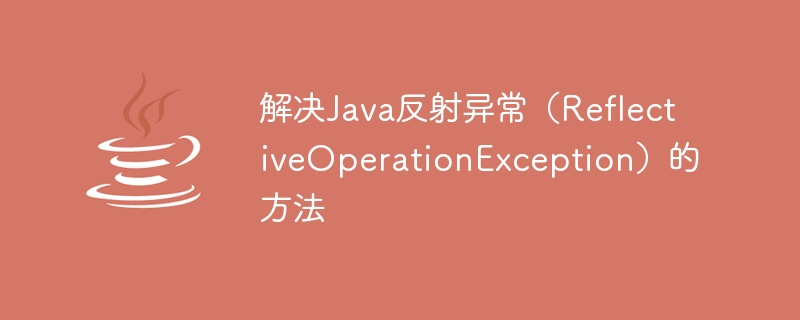

Methods to solve Java reflection exceptions (ReflectiveOperationException)
In Java development, reflection (Reflection) is a powerful mechanism that allows the program to dynamically Obtain and operate classes, objects, methods, properties, etc. Through reflection, we can implement some flexible functions, such as dynamically creating objects, calling private methods, obtaining class annotations, etc. However, using reflection also brings some potential risks and problems, one of which is ReflectiveOperationException.
Reflection exceptions are a set of exception classes provided by the Java standard library, including ClassNotFoundException, InstantiationException, IllegalAccessException and NoSuchMethodException, etc. When we use reflection, these exceptions will be thrown if an exception occurs such as the class does not exist, cannot be instantiated, cannot be accessed, or the method is not found. Next, we will introduce some common methods to solve reflection exceptions and provide corresponding code examples.
public void reflectMethod() { try { Class clazz = Class.forName("com.example.MyClass"); Method method = clazz.getMethod("myMethod"); method.invoke(null); } catch (ClassNotFoundException e) { System.out.println("Class not found: " + e.getMessage()); } catch (NoSuchMethodException e) { System.out.println("Method not found: " + e.getMessage()); } catch (IllegalAccessException e) { System.out.println("Illegal access: " + e.getMessage()); } catch (InvocationTargetException e) { System.out.println("Invocation target exception: " + e.getMessage()); } }
public void reflectMethod() { try { Class clazz = Class.forName("com.example.MyClass"); Method method = clazz.getMethod("myMethod"); method.invoke(null); } catch (ReflectiveOperationException e) { Throwable cause = e.getCause(); if (cause instanceof IOException) { System.out.println("IO exception occurred: " + cause.getMessage()); } else { System.out.println("Unknown exception: " + cause.getClass().getSimpleName()); } } }
public class ReflectionExceptionHandler { public void handleReflectiveOperationException(ReflectiveOperationException e) { if (e instanceof ClassNotFoundException) { System.out.println("Class not found: " + e.getMessage()); } else if (e instanceof NoSuchMethodException) { System.out.println("Method not found: " + e.getMessage()); } else if (e instanceof IllegalAccessException) { System.out.println("Illegal access: " + e.getMessage()); } else if (e instanceof InvocationTargetException) { System.out.println("Invocation target exception: " + e.getMessage()); } else { System.out.println("Unknown exception: " + e.getClass().getSimpleName()); } } }
public void reflectMethod() { try { Class clazz = Class.forName("com.example.MyClass"); Method method = clazz.getMethod("myMethod"); method.invoke(null); } catch (ReflectiveOperationException e) { ReflectionExceptionHandler handler = new ReflectionExceptionHandler(); handler.handleReflectiveOperationException(e); } }
When handling reflection exceptions, choose the appropriate processing method according to specific business needs and situations, such as printing exception logs, rolling back transactions, returning default values, etc.
Summary:
Reflection exceptions are a common problem in Java development, but we can deal with it by adopting some effective solutions. The most common methods include catching and handling exceptions, obtaining the cause of the underlying exception, and creating custom exception handling classes. Through these methods, we can handle and control reflection anomalies more flexibly, improving the robustness and reliability of applications.
Note: When using reflection, try to avoid dealing with reflection exceptions directly. Instead, take appropriate checks and preventive measures where exceptions may occur to reduce the occurrence of reflection exceptions.
The above is the detailed content of Methods to solve Java reflection exception (ReflectiveOperationException). For more information, please follow other related articles on the PHP Chinese website!
